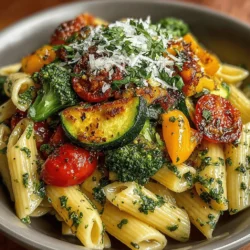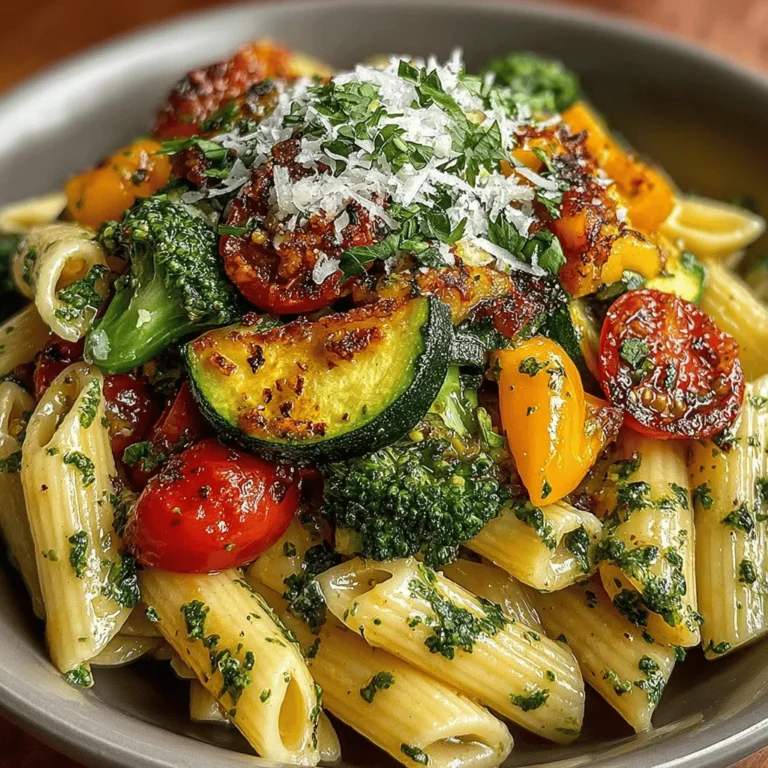Vibrant Pasta Primavera with Garlic Herb Sauce: A Fresh Take on a Classic Dish
Pasta Primavera is not just a meal; it’s a celebration of fresh, vibrant flavors and seasonal produce. Originating from Italian cuisine, this dish has evolved to become a popular choice among food lovers around the globe, especially for those who appreciate the bounty of vegetables. The beauty of Pasta Primavera lies in its colorful medley of vegetables, which not only enhance the visual appeal of the dish but also contribute to a delightful array of flavors. This recipe is perfect for vegetarians and anyone seeking a light, satisfying meal that can be whipped up in no time. Whether you’re preparing a weeknight dinner or impressing guests at a special occasion, Pasta Primavera offers both ease and elegance.
Understanding Pasta Primavera
The term “Primavera” translates to “spring” in Italian, and indeed, this dish epitomizes the essence of springtime through its use of fresh, seasonal vegetables. While its roots can be traced back to Italy, the dish gained popularity in America during the 1970s, thanks in part to the culinary innovations introduced by Italian-American chefs. Initially, Pasta Primavera was a simple dish featuring pasta tossed with a variety of sautéed vegetables, often in a light sauce. Over the years, it has transformed into a canvas for culinary creativity, allowing home cooks and chefs alike to adapt the recipe to showcase whatever vegetables are in season.
This versatility is a significant reason for Pasta Primavera’s enduring appeal. Cooks can select from a wide range of vegetables, making it easy to customize the dish based on personal preferences or local availability. The result is a vibrant and nutritious meal that can change with the seasons, offering a freshness that is hard to resist.
Ingredients Breakdown
To create a mouthwatering Pasta Primavera, understanding the ingredients is key. The following components not only contribute to the dish’s flavor but also offer various nutritional benefits.
Pasta Choices
When it comes to pasta, the options are nearly endless, but two of the most popular choices for Pasta Primavera are spaghetti and penne.
– Spaghetti is long and thin, allowing for a delightful twirling around your fork. It captures the sauce well and complements the lighter garlic herb sauce beautifully.
– Penne, on the other hand, features a tubular shape that provides a satisfying bite and a unique texture. Its ridges help hold onto the sauce and any accompanying vegetables, making each mouthful a burst of flavor.
Both pasta types are excellent choices, and the decision often comes down to personal preference or the type of dining experience you wish to create.
Fresh Vegetables
The heart of Pasta Primavera lies in its vegetables. A well-rounded dish typically includes bell peppers, zucchini, cherry tomatoes, and broccoli. Each of these ingredients adds its distinct character:
– Bell Peppers: Available in a rainbow of colors, bell peppers bring sweetness and crunch to the dish. Their vibrant hues add not just flavor but also visual appeal.
– Zucchini: This mild-flavored vegetable lends a tender texture and absorbs the flavors of the sauce beautifully. When sautéed, zucchini becomes soft and slightly sweet.
– Cherry Tomatoes: Bursting with juiciness, cherry tomatoes add a refreshing burst of flavor. Their natural sweetness balances out the dish and provides a lovely pop of color.
– Broccoli: Rich in vitamins and minerals, broccoli adds a hearty component to the dish. Its slight bitterness contrasts nicely with the sweetness of the other vegetables, creating a well-rounded flavor profile.
Selecting the freshest produce is essential for achieving the best results. Look for vegetables that are vibrant in color, firm to the touch, and free from blemishes. Seasonal vegetables not only taste better but also provide the best nutritional value.
Herbs and Aromatics
No Pasta Primavera is complete without the aromatic touch of herbs. This recipe emphasizes the use of garlic, basil, and parsley, each contributing to the depth of flavor in the garlic herb sauce.
– Garlic: This aromatic staple enhances the dish with its robust flavor. Fresh garlic provides a pungent, slightly sweet taste that infuses the sauce and vegetables beautifully.
– Basil: Known for its sweet and slightly peppery flavor, fresh basil elevates the dish, adding a fragrant note that complements the vegetables perfectly.
– Parsley: Often used as a garnish, parsley contributes a fresh, bright flavor that lightens the overall dish. Fresh parsley is preferred for its vibrant taste, but dried parsley can suffice in a pinch.
The choice between fresh and dried herbs can significantly impact the dish’s flavor. Fresh herbs offer a more pronounced aroma and taste, while dried herbs tend to be more concentrated. For the best results, opt for fresh herbs when possible.
Finishing Touches
To elevate the flavors of your Pasta Primavera, a few finishing touches can make all the difference.
– Lemon Juice: A splash of fresh lemon juice brightens the dish, adding acidity that balances the richness of the pasta and sauce. It also enhances the overall freshness of the vegetables.
– Parmesan Cheese: This classic Italian cheese adds a salty, nutty flavor that harmonizes with the other ingredients. A sprinkle of freshly grated Parmesan cheese before serving not only enhances taste but also adds a visually appealing touch.
Step-by-Step Cooking Instructions
Now that you understand the key components of this recipe, it’s time to dive into the cooking process. This detailed walkthrough will ensure you achieve a perfect Pasta Primavera every time.
Cooking the Pasta
To start, bring a large pot of salted water to a boil. This is a crucial step, as salting the water ensures that the pasta is seasoned from the inside out. Once the water is boiling, add your chosen pasta—whether it’s spaghetti or penne—and cook according to the package instructions until al dente. The ideal cooking time can vary, but typically ranges from 8 to 12 minutes.
As the pasta cooks, remember to reserve about a cup of the pasta water before draining. This starchy water can be a game-changer when it comes to thinning out your sauce later, ensuring it clings beautifully to the pasta.
Sautéing the Vegetables
While the pasta is cooking, it’s time to prepare the vegetables. In a large skillet, heat a drizzle of olive oil over medium heat. Once hot, add minced garlic and sauté for about 30 seconds until fragrant, being careful not to let it burn. Next, add your selected fresh vegetables, starting with the firmer ones like broccoli and bell peppers, allowing them to sauté for a few minutes. Then, add the softer vegetables like zucchini and cherry tomatoes, cooking until they are just tender but still vibrant in color.
As the vegetables cook, season them with salt and pepper to taste, allowing their natural flavors to shine. This quick sautéing process helps retain the freshness of the vegetables while ensuring they are perfectly cooked.
With the pasta cooked and the vegetables sautéed, you are well on your way to crafting a deliciously vibrant Pasta Primavera with Garlic Herb Sauce. Stay tuned for the next steps, where we’ll combine these elements into a harmonious dish that showcases the best of what seasonal produce has to offer.
{{image_2}}
Sautéing Garlic and Vegetables
To achieve the perfect Pasta Primavera, mastering the technique of sautéing garlic and vegetables is crucial. Begin by heating a generous amount of olive oil in a large skillet over medium heat. The oil should shimmer slightly but not smoke, indicating that it’s hot enough for cooking.
Timing and Heat
The timing of adding garlic is vital; it should be sautéed for just about 30 seconds until fragrant, ensuring it doesn’t burn. Burnt garlic can impart a bitter flavor to your dish, which is something we want to avoid. Once the garlic is aromatic, introduce your selection of vegetables.
Consider using a mix of bell peppers, zucchini, cherry tomatoes, and snap peas for a colorful presentation. Add the vegetables to the pan in stages, starting with those that take longer to cook, such as bell peppers and zucchini. After a couple of minutes, add faster-cooking vegetables like snap peas and tomatoes. The goal is to maintain a crisp texture with vibrant colors. Stir occasionally to ensure even cooking, and season with salt and pepper to enhance the flavors.
Combining Ingredients
Once the pasta is cooked al dente, and the vegetables are sautéed to perfection, it’s time to combine everything. This step is essential for creating a cohesive dish.
Mixing Pasta and Vegetables
Using tongs or a large fork, gently lift the drained pasta from the pot and transfer it directly into the skillet with the sautéed vegetables. Reserve a cup of pasta water before draining; this starchy water can be added later to adjust the sauce’s consistency.
Carefully toss the pasta and vegetables together over medium heat. This allows the flavors to meld beautifully. If the dish appears dry, gradually add the reserved pasta water, one tablespoon at a time, until you achieve the desired level of moisture. The goal is to have a light coating of sauce that clings to the pasta without drowning it.
Incorporating Herbs and Cheese
Now comes the final touches that elevate your Pasta Primavera. Fresh herbs and cheese add layers of flavor that make this dish truly delightful.
Adding Fresh Herbs
Incorporate a handful of freshly chopped basil and parsley into the pasta mixture. The herbs should be added just before serving to retain their vibrant color and fresh taste. Toss everything gently to ensure the herbs are evenly distributed throughout the dish.
Cheese Balance
For a richer flavor profile, sprinkle grated Parmesan cheese over the top. Start with a modest amount, tossing it gently to combine. The heat from the pasta will slightly melt the cheese, creating a creamy texture. Taste the dish and adjust the seasoning as needed, adding more cheese, salt, or pepper to balance the flavors.
Serving Suggestions
Presentation is key when serving Pasta Primavera. Here are a few ideas to enhance the visual appeal:
1. Garnishing: Finish with a sprinkle of freshly grated Parmesan, a drizzle of high-quality olive oil, and a few whole basil leaves on top for a pop of color.
2. Plating: Serve the pasta in shallow bowls to showcase the vibrant colors of the vegetables. This helps create an inviting presentation that is sure to impress.
3. Accompaniments: Pair the dish with a side of crusty bread or a light green salad dressed with lemon vinaigrette to balance the meal.
Nutritional Information
Pasta Primavera is not only a feast for the eyes but also a healthy choice for your meals. Here’s a breakdown of its nutritional benefits:
Health Benefits of Vegetables
The variety of vegetables used in Pasta Primavera provides essential vitamins, minerals, and antioxidants. For example:
– Bell Peppers are rich in vitamin C, which supports immune function.
– Zucchini is low in calories and high in fiber, promoting digestive health.
– Cherry Tomatoes are packed with lycopene, a powerful antioxidant linked to various health benefits.
Role of Olive Oil
Olive oil serves as a healthy fat source, providing monounsaturated fats known to be heart-healthy. It also contains antioxidants that can help reduce inflammation.
Protein Content
Parmesan cheese adds a good dose of protein, which is essential for muscle repair and growth. For those seeking a vegetarian option, the cheese can provide adequate protein as part of a balanced diet.
Dietary Adaptability
Pasta Primavera is versatile, fitting into various dietary lifestyles. It can be made vegan by omitting cheese or using a plant-based alternative. For gluten-free diets, substitute traditional pasta with gluten-free options made from rice, quinoa, or legumes.
Variations of Pasta Primavera
One of the beauty of Pasta Primavera is its adaptability. Here are some creative variations to consider:
Protein Additions
To make the dish heartier, consider adding protein. Grilled chicken, shrimp, or even plant-based proteins like chickpeas or tofu can enhance the nutritional profile while keeping the dish balanced.
Exploring Different Vegetables
Don’t hesitate to experiment with seasonal vegetables. Asparagus, carrots, and spinach can easily replace or complement the traditional vegetables. In spring, fresh peas can add sweetness, while in fall, roasted butternut squash can provide a unique flavor twist.
Sauce Alternatives
If you want to change things up, consider altering the sauce. A light cream-based sauce or a vegan alternative using cashew cream can provide a different flavor profile while maintaining the dish’s essence. For a kick, try adding a splash of lemon juice or a hint of chili flakes for some heat.
Conclusion
In summary, Pasta Primavera is a vibrant, healthy, and easy-to-prepare dish that celebrates the flavors of fresh vegetables and herbs. Its versatility makes it a perfect addition to any meal repertoire, allowing you to cater to a variety of dietary preferences and seasonal ingredients.
By mastering the art of sautéing, balancing flavors with herbs and cheese, and presenting the dish beautifully, you can create a culinary experience that delights the senses. Embrace your creativity in the kitchen, and enjoy the colorful flavors of this classic dish. Whether served as a main course or a side dish, Pasta Primavera is sure to impress and satisfy everyone at your table.


